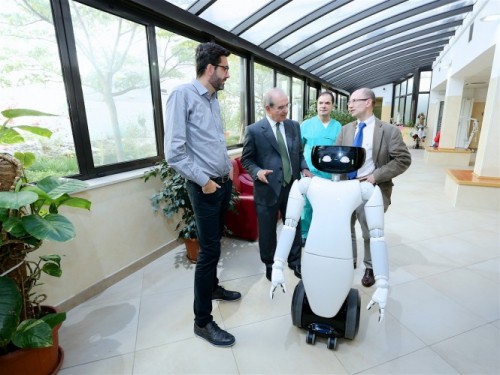 Thanks to a collaboration with the scientific research centre IIT - Istituto Italiano di Tecnologia, in October 2018 Konica Minolta has started a study with robots in the “Casa Sollievo della Sofferenza” hospital in San Giovanni Rotondo, Foggia. Konica Minolta is one of the leading companies to drive forward research activities in robots that offer assistance in the healthcare domain.
Thanks to a collaboration with the scientific research centre IIT - Istituto Italiano di Tecnologia, in October 2018 Konica Minolta has started a study with robots in the “Casa Sollievo della Sofferenza” hospital in San Giovanni Rotondo, Foggia. Konica Minolta is one of the leading companies to drive forward research activities in robots that offer assistance in the healthcare domain.
Konica Minolta, Inc. (Konica Minolta) continues its investment in research and development within the field of Distributed Robotics and Artificial Intelligence (AI) within the care sector. After the opening of most recent research centre in Rome, the company’s commitment moves forward with an important partnership with IIT - Istituto Italiano di Tecnologia and the hospital Casa Sollievo della Sofferenza in San Giovanni Rotondo, Foggia, Italy. The goal is to study the introduction of assistive robotics in the healthcare domain, employing robots that can assist patients, support the work of nurses and doctors and carry out basic monitoring activities.
The global medical robotics market is continually increasing. According to a MARKETSANDMARKETS report, it is forecasted to reach USD 16.7 billion by the year 2023, from an estimated USD 6.5 billion in 2018. The scope that can be covered by medical robots is vast and it includes surgical robots, rehabilitation robots, non-invasive radiosurgery robots and pharmacy dispensing robots. Konica Minolta is one of a few companies within Europe that are tackling the challenge of using robots for patient assistance.
The ‘Casa Sollievo della Sofferenza’ hospital, with its 900 beds, 206 residential elderly care beds, 2,900 employees, 60,000 yearly admissions and 9,500 surgeries per year, is one of the most renowned in Italy and in partnership with Konica Minolta and IIT are initiating activities into assistive robotics. As part of a collaboration between the two research institutions, IIT has provided its ‘R1’ humanoid robot, developed to be able to assist people in different scenarios; and Konica Minolta Laboratory Europe brought its expertise in AI and Distributed Robotics.
R1 has an innovative structure, 50% of its body is composed of plastic materials; the customised Artificial Intelligence embedded within the robot is inspired by both human learning and human interaction capabilities. R1 is today able to recognise people and objects and as part of the collaboration with Konica Minolta it will have a more sophisticated interaction with doctors and patients by better understanding their activities and responding to their requests accordingly.
“At the Hospital Casa Sollievo della Sofferenza, we have welcomed Konica Minolta Laboratory Europe, to deploy robotic systems within the hospital,” says Francesco Giuliani, ICT, Innovation & Research Manager at IRCCS Casa Sollievo della Sofferenza. “In the current setup we are starting to use the R1 robot of IIT - Istituto Italiano di Tecnologia, to accompany a patient during their daily routines. This experience is part of our current projects aimed at optimising health care professionals’ time”.
Francesco Puja, Research Specialist for Distributed Robotics at Konica Minolta, explains more: “Our solutions enhance robots with increased cognitive abilities. Activity and object recognition, emotion and behaviour analysis enable robots to perceive the environment, understand it and behave properly.”
“We are only at the beginning of a wider research collaboration with medical institutions that in a few years could make assistive robotics become a widespread asset in hospitals and nursing homes,” says Filippo Silva, R&D Strategy and Technology Manager of Konica Minolta Laboratory Europe in Rome. “The ultimate goal is to orchestrate multiple robots and to leverage on the IoT to extend the perception to support the business of the future.”
“The R1 robot was conceived to operate in many different professional contexts, from retail to surveillance, with rehabilitation and assistive capabilities for domestic and hospital environments”, says Giorgio Metta, Scientific Deputy Director of IIT and responsible for the R1 project. “The collaboration with Konica Minolta and with the hospital Casa Sollievo della Sofferenza represents one of the steps that IIT is following to further develop this research prototype into a fully operational system for everyday use.”
In close collaboration with clinical users, in its four R&D laboratories throughout Europe, Konica Minolta is exploring how digital technologies shape the future of healthcare. Beyond assistive robotics, Konica Minolta conducts research into applications of its semantic technologies to medical documents. In the field of precision medicine, the dedicated lab in Munich develops advanced image and data analytics solutions.
{youtube}iZFHKb5aS_o{/youtube)
{youtube)sAWXRyKGOU8{/youtube}